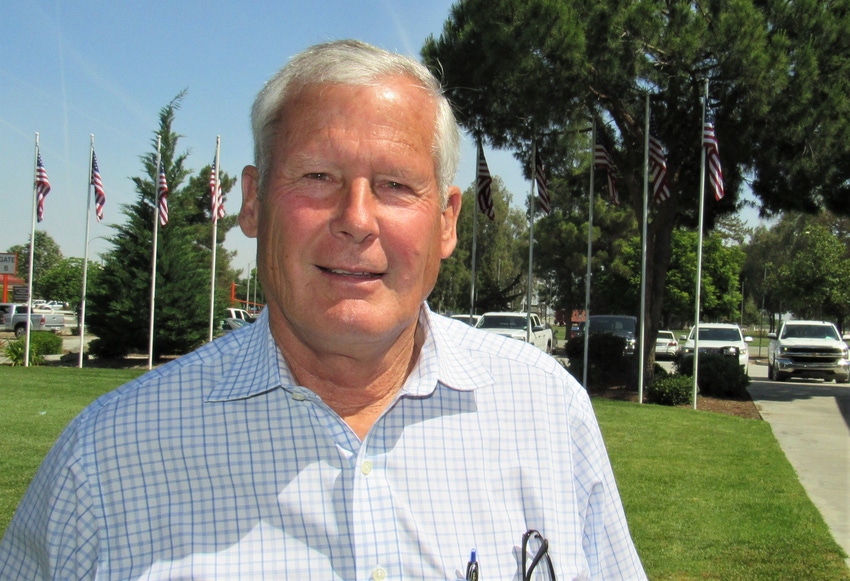
Long before it became fashionable in the San Joaquin Valley to talk about groundwater overdraft and land subsidence, Don Cameron was noticing it.
“We know we have a problem out there,” the Helm, Calif., grower says. “When I first started farming we saw the water table drop 2 feet in a year. It just kept dropping and dropping.”
Another thing he kept noticing was that in wet years, storm waters would rush down the Kings River on their way to the Pacific Ocean. The river’s north fork abuts Cameron’s Terranova Ranch, which grows tree nuts, wine grapes and other crops on about 7,500 acres of sandy ground.
So Cameron set out to resolve both issues, by capturing some of the storm water and using it to recharge the aquifer underneath his fields. He obtained a federal conservation grant in 2010 and began flooding his pistachio, wine grape and alfalfa fields during a wet winter the following year.
‘YOU HAVE TO LEARN’
“We took a risk,” Cameron said at the Almond Board of California’s recent Navigating the Waters workshop in Tulare. “But you have to learn. We tried it and fortunately we didn’t kill the vines.”
Since then, Cameron has received more grant funding and started additional recharge projects. In 2017 he flooded his vineyards and pistachio orchards again, and this year he was doing walnuts, he says. He’s also tried recharge in his almond fields after bloom.
“I think the issue here is you’ve got work to do in the fields” in April and May, he says. “We flooded and then backed off. But these are issues we’ve got to think about.”
Cameron is collecting data for monitoring wells in a research project led by University of California, Davis hydrologist Helen Dahlke.
“We want to know ahead of time if we’re going to cause an issue,” says Cameron, who has chaired the state Board of Food and Agriculture since early 2018.
ON THE GROUND FLOOR
As it turned out, Cameron got in on the ground floor of a veritable revolution in water conservation. His effort started before the National Aeronautics and Space Administration’s 2015 and 2017 reports that subsidence – the sinking of land because of a shrinking water table – is at historic levels in the San Joaquin Valley.
It began before studies by the University of California, the Almond Board of California and the California Water Foundation suggested that flooding alfalfa fields and almond orchards during winter months could improve the health of aquifers. And it started well before the passage of the Sustainable Groundwater Management Act in 2014 prompted everyone to scramble for ways to preserve the resource.
“We think we can limit groundwater decline and improve water quality,” Cameron says.
A graduate of California State University, Fresno with a degree in biology, Cameron has been vice president and general manager of Terranova Ranch, Inc., since 1987. The farm about 25 miles southwest of Fresno includes about 6,000 acres of its own crops as well as 1,500 acres custom-farmed for other clients.
The farm’s 25 conventional, organic and biotech crops include processing tomatoes, peppers, onions, seed product, corn and other annuals, in addition to walnuts, almonds, pistachios, wine grapes and olives for oil. Cameron also owns Prado Farms in Fresno County, according to a biography on the state board of food and ag’s website.
In addition to his work with the board, Cameron currently chairs the California Cotton Alliance and the McMullin Area Groundwater Sustainability Agency, is a director and past chairman for the California Tomato Growers Association, and is a director for Western Growers and the Raisin City Water District.
He was named the 2017 Agriculturalist of the Year by the Fresno Chamber of Commerce, and Terranova Ranch was given a 2017 Governor’s Environmental Leadership Award for his flood capture and recharge project.
FLOODING FIELDS
The project began with a grant from the USDA’s Natural Resources Conservation Service, which enables him to take excess water from the river during wet winters for recharge. The practice has saved several downstream farms and communities from flooding, he says.
After initially applying water to his pistachio, wine grape and alfalfa fields as well as open ground that was slated to be planted with tomatoes, Cameron reported seeing no decreases in yields from any of the crops the next season.
Flows on the Kings River can fluctuate, but they’re generally consistent, Cameron says.
“When it floods, there’s really a lot of water,” he says.
Part of the challenge for Cameron has been building the conveyance system to move large amounts of water to his almond orchards and other fields with soils that are most conducive to recharge, he says.
“These flood flows run fast and run big,” Cameron says. “You’ve got to have the capacity to capture them and bring them on-farm.”
Approvals for various aspects of the project can be slow in coming. For instance, Cameron obtained a grant from the state Department of Water Resources in 2012 and only started moving dirt in 2018, he says.
“Any project you want to do takes time,” he says.
“I spend about 70 percent of my time on water issues, which is crazy,” Cameron says. “I love to farm, but without water you’re done.”
About the Author(s)
You May Also Like






